Digital advertising headwinds to fuel the takeoff of connected TV
While the crumbling third-party cookie – combined with privacy-centric gatekeeping policies imposed by the likes of Apple, Facebook and Google – diminishes advertisers’ ability to reach target audiences across the digital ecosystem, the connected television (CTV) space has a valuable opportunity to evolve to meet advertisers’ needs. John Hamilton, founder and chief executive officer at TVDataNow, spells out why marketers should be investing in CTV today.

CTV is currently poorly optimized for advertisers
The widespread shift toward data privacy-centric policies in the tech space has left advertisers at a loss. However, with viewership numbers rising, measurement improving and a proliferation of major platforms in the space, the burgeoning world of CTV is the next frontier for effective advertising.
Tech players muddle marketers’ MO
The cookie-apocalypse has only been delayed, not canceled. Google’s long-awaited announcement that it will phase out third-party cookies from Chrome was the final nail in the coffin of the data-sharing environment that drove an explosion in digital media.
Google is, in fact, way behind the competition. Apple banned third-party cookies from Safari in 2020 and Mozilla has made privacy the defining trait of its Firefox browser.
Recent consumer requests for better data protection has made abundantly clear how unpopular cookies were to the public once consumers were made aware of them. And the proliferation of companies building data-rich profiles of individual consumers without their knowledge or consent meant this advertising building block was always on borrowed time. Once advocacy groups and the government started getting involved, Google pre-empted them.
While friendly media has positioned the move as a privacy decision, for Google it is a business decision. Eliminating cookies enables Google to better control the data collected on its platforms for its own betterment – and it creates the potential for other tolls it could enforce on its browser highway.
This much is true: the elimination of third-party cookies will drastically change how advertisers target and measure the performance of core digital and make it difficult to justify investments in core digital channels.
Meanwhile, Facebook, another major digital player, has for years held advertisers hostage by claiming a huge audience. By misstating video view statistics, routinely altering policies on a whim and cutting off Facebook pages’ ability to reach their entire audience without paying to boost a post, Facebook has consistently changed the rules of the game – to the advertiser’s detriment.
Advertisers are waking up to the fact that Google, Facebook, Apple and Amazon are dominating the digital media space while investing less in supporting advertiser success. Performance marketers would be wise to look to new horizons for their advertising spend. Fortunately, there is an emerging and underinvested medium: connected television (CTV).
Capitalizing on captive audiences
While the pandemic rendered most people homebound, thereby driving up digital, perhaps no medium benefited more than CTV. Many consumers used their disposable income on a new TV purchase, which was nearly certain to include some software enabling easy access to CTV publishers. According to The NPD Group, purchases of TVs 65 inches and larger were up 53% over the first half of 2020.
And what did consumers do with those brand new TVs? Stream content. According to recent research by CTV player SpotX, the average time spent streaming content on CTV per day in 2020 was three hours – up almost 40% from the daily rate in 2018. Meanwhile, consumption of live TV viewership has decreased.
In addition to premium streaming apps such as HBO Max, Disney+, and Apple+, there are a host of ad-supported free providers including Pluto (with 40 million monthly active users [MAU]), Tubi (with 45 million MAU) and STIRR, some of which are owned by major cable companies or movie studios. And of course there is Hulu, a constellation of content providers now owned by Disney, which offers both ad-supported and premium tiers.
The sheer volume of providers means the CTV landscape and ecosystem is incredibly fragmented – and this fragmentation will only increase as other players both small and large enter the marketplace.
Why is this exciting to performance marketers? Well, for one, CTV publishers and platforms welcome the use of third-party cookies and other technologies that balance privacy with optimal targeting and tracking.
Second, CTV has a captive audience. CTV is a ‘lean-back environment’ where the consumer is passively consuming the content in front of them and thereby actually consuming the ads as they come onscreen. Whereas digital media has never been able to exactly pinpoint if someone is actively watching a pre-roll ad, CTV has some ways to more accurately do so. If someone is skipping an ad, they’re still seeing it and it’s definitive proof they are there and engaged.
And yet CTV is currently poorly optimized for advertisers. As cross-device trackability increases, it will be able to show real ROI (for example, we can easily determine someone is watching a program where they are shown an ad for product X; then we will be able to track that they order it from the phone, tablet or computer).
The ROI will only improve. In short, CTV may become more measurable than core digital, which will bring more players into the space. Companies will straddle publishers and platforms, including so called ‘walled-gardens’, to provide analytics, guidance, optimization and targeting recommendations.
Now is the time for performance marketers to launch and test in CTV, before the rest of the marketplace gets wise to this emerging opportunity. Digital advertising’s headwinds are CTV’s tailwinds.
John Hamilton is founder and chief executive officer at TVDataNow.
